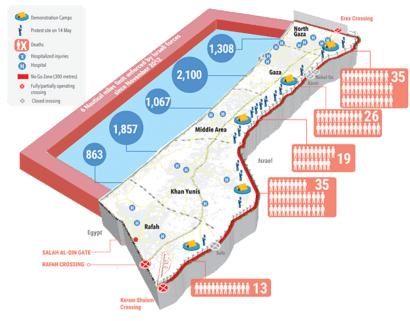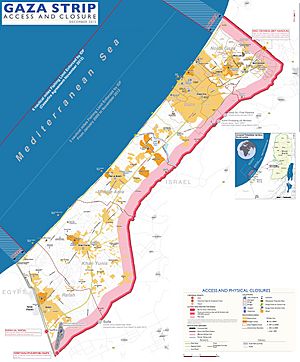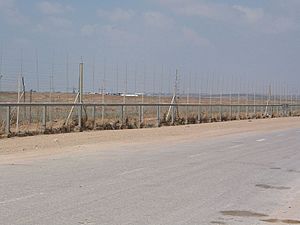2018–2019 Gaza border protests facts for kids
Quick facts for kids 2018–2019 Gaza border protests |
|||
|---|---|---|---|
| Part of Gaza–Israel conflict | |||

UN OCHA map of the protests, 31 May 2018
|
|||
| Date | 30 March 2018 – 27 December 2019 (1 year, 8 months, 3 weeks and 6 days) |
||
| Location |
Gaza Strip, near the Israeli border
|
||
| Goals |
|
||
| Concessions given |
None | ||
| Parties to the civil conflict | |||
|
|||
| Casualties | |||
|
|||
The 2018–2019 Gaza border protests, also known as the Great March of Return, were a series of demonstrations. These protests happened every Friday in the Gaza Strip, close to the border with Israel. They started on March 30, 2018, and continued for many months.
People taking part in the protests had two main demands. First, they wanted Palestinian refugees to be allowed to return to the lands they left in what is now Israel. Second, they protested against Israel's blockade on Gaza. This blockade limits what can enter and leave Gaza.
Independent activists first organized these demonstrations. Soon, Hamas, which governs the Gaza Strip, and other groups supported the protests. The protests were planned to last from March 30, 2018 (a day called Land Day) until May 15 (known as Nakba Day). However, they went on for almost 18 months. Hamas announced on December 27, 2019, that the protests would be put on hold.
About 30,000 Palestinians joined the first protest on March 30. Even larger protests happened on later Fridays, with at least 10,000 people each time. Most demonstrators protested peacefully, staying far from the border fence. However, some groups, mostly young men, went closer to the fence. Israeli officials stated that Hamas used these protests to cover attacks against Israel.
Many Palestinians were killed or injured during these protests. From March 30 to May 15, 2018, at least 110 Palestinians died. Israeli soldiers used tear gas and live bullets. By June 2018, over 13,000 Palestinians were wounded, many seriously. Only a few Israelis were hurt during this time.
Many human rights groups and the United Nations criticized Israel's use of force. They called for investigations into the deaths of Palestinian protesters. The Israeli government, however, praised its soldiers for protecting the border. In early 2019, a UN commission found that most of the Palestinian deaths and injuries were not justified. They suggested that Israel should investigate if serious international law violations had occurred.
Contents
Why the Protests Happened
Life in Gaza
In 2005, Israel removed its forces from the Gaza Strip. The Palestinian National Authority then took control. But Israel still controls many parts of daily life in Gaza. This includes its air and sea space, most land crossings, and supplies like electricity and water. Human rights groups say Palestinians in Gaza are still protected by international rules.
After a conflict in 2007, Hamas took full control of Gaza. This led Israel and Egypt to put a blockade on the Gaza Strip. This blockade has made life very difficult for people living there.
The Border Area
After a conflict in 2014, the situation in Gaza became even worse. Hamas found it hard to manage daily life. They hoped to get the Palestinian Authority to help, but this did not work out. Some believe Hamas used the protests to try and solve its problems, as armed conflict with Israel had not been successful.
A main reason for the protests was the demand for the Palestinian right of return. This means Palestinian refugees and their families want to return to their original homes in what is now Israel. Most people in Gaza are descendants of refugees from the 1948 Palestine War. Israel has said no to this demand. They worry that if too many Palestinians returned, Jewish people would become a minority in Israel.
Gaza's Restricted Border Zone
After 2005, Israel created a "no-go zone" inside the Gaza border. This was to stop rocket attacks from Gaza. This zone prevents Palestinians from entering about 17% of Gaza's land. This includes a third of its farming areas. The Israeli army says this zone helps prevent hidden explosives and other dangerous activities.
The border fence between Gaza and Israel is made of barbed wire and a "smart fence" with sensors. This fence is designed to detect people trying to cross it.
How the Protests Were Planned
In 2011, a man named Ahmed Abu Ratima had an idea. He thought Palestinians could peacefully go to the border fence. They would demand their right to return to their old homes.
In early 2018, a journalist named Muthana al-Najjar set up a tent near the border. He stayed there for over a month. Others started planting olive trees in the area. They tried to keep the protest separate from political groups like Hamas. But Hamas soon took over the protest. They encouraged thousands of Gazans to join the march. They used TV, local news, and social media to spread the word. Hamas reportedly planned to have security people in plain clothes among the protesters. Their goal was to prevent violence.
The march gained support from thinkers and university graduates in Gaza. They were inspired by people like Martin Luther King Jr. and Mahatma Gandhi, who led peaceful protests.
By March 2018, Hamas and other Palestinian groups supported the protests. All groups participated under the shared symbol of the Palestinian national flag.
Reactions to the Protests
Countries' Responses
The violence in Gaza worried many Arab countries. Jordan and Egypt criticized Israel's use of force. They said it hurt efforts to make peace. The leaders of Turkey and Israel also argued about the border clashes. Turkey's President called Israel's actions "inhumane."
Australia and the United States supported Israel's right to defend itself. Other countries like France, Germany, and South Africa criticized the actions of Israel or both sides.
The British Prime Minister called for an independent investigation into what happened. The U.S. Ambassador to the UN said Hamas should stop using children in the conflict.
International Organizations' Responses
- Arab League: This group of Arab countries condemned the violence against Palestinian protesters. They held a meeting to discuss how to respond.
- European Union: The EU was very concerned about Israel's use of live bullets to control crowds. They asked Israel to investigate every death.
- International Criminal Court: The prosecutor for this court warned that violence against civilians could be considered serious international crimes.
- United Nations: The UN Secretary-General said the situation showed how urgent it was to restart peace talks. UN officials said Gaza was close to "exploding" and called for actions to prevent another war. The UN High Commissioner for Human Rights said Israel's use of deadly force was mostly not justified. They stated that approaching the fence alone was not a threat to life that would allow using live bullets.
Non-Governmental Groups' Responses
- Amnesty International: This organization called for a worldwide ban on selling weapons to Israel. They said Israel's response to the protests was too strong.
- Shurat HaDin: This Israeli law group filed a complaint with the International Criminal Court. They accused Hamas leaders of using children as human shields. They said this was a serious international crime.
Images for kids
-
Protest in San Sebastián, Spain, May 15, 2018. It shows an Israel flag crossed out.
-
Protest in Tehran, Iran, May 18, 2018. This protest showed support for Gaza.
See also
 In Spanish: Protestas fronterizas de Gaza de 2018-2019 para niños
In Spanish: Protestas fronterizas de Gaza de 2018-2019 para niños






